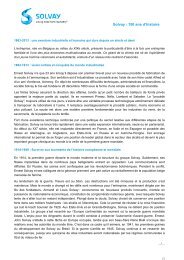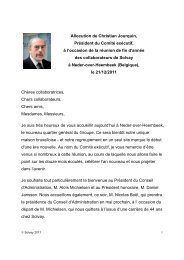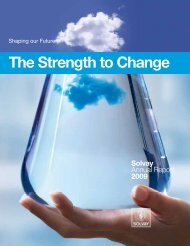THE FUTURE, - Solvay
THE FUTURE, - Solvay
THE FUTURE, - Solvay
Create successful ePaper yourself
Turn your PDF publications into a flip-book with our unique Google optimized e-Paper software.
210019<br />
SYN<strong>THE</strong>SIS OF ‘GREEN’ DI- AND<br />
POLYGLYCEROL VIA POLYCONDENSATION<br />
OF BIOGLYCEROL<br />
New synthesis route<br />
proves outright winner<br />
<strong>THE</strong> PROJECT. The main markets for<br />
diglycerol and polyglycerol are directed towards<br />
cosmetics and food additives. Customers are<br />
therefore naturally sensitive to the origin of their<br />
raw materials and give preference to those<br />
of natural origin (not derived from petroleum).<br />
Moreover, the trend towards commoditization<br />
of di-and polyglycerol is placing further pressure<br />
on prices. Until recently, our production process<br />
was based in part on epichlorohydrin, an<br />
expensive raw material derived from petroleum,<br />
making it very uncompetitive compared to that<br />
used by our competitors.<br />
To meet our customers’ expectations, but also<br />
the threat of extinction of our business, a new<br />
synthesis method has been successfully<br />
developed.<br />
It takes natural glycerin (a renewable resource)<br />
as the sole raw material, and polycondenses it in<br />
a new way, limiting the quantities of reagents<br />
and discharges through the use of an appropriate<br />
catalyst. Compared with the traditional method<br />
of condensation of epichlorohydrin (derived from<br />
propylene, a non-renewable petroleum product)<br />
and glycerol, this new way is simpler while<br />
maintaining the good specifi cations of the fi nished<br />
product. Most importantly, it reduces production<br />
costs by 35% thus ensuring profi tability. Finally,<br />
the products synthesized in this way are eco<br />
certifi ed, opening up new markets and allowing<br />
our customers also to be more competitive.<br />
SBU EDS<br />
>Werner Siemanowski; Patrick Gilbeau.<br />
210069<br />
PCS PROCESS IMPROVEMENTS<br />
Better control through<br />
observation<br />
<strong>THE</strong> PROJECT. The sodium percarbonate<br />
market in the USA is very diffi cult, with losses<br />
of around USD two million recorded in 2007.<br />
Thanks to a newly developed grade, FB700C,<br />
we are expecting profi ts that signifi cantly exceed<br />
budget.<br />
The secret lies in controlling the granulometry<br />
of the powder, produced by the fl uid bed process,<br />
and in the coating, which gives it improved<br />
chemical and thermal stability when mixed with<br />
the other ingredients of concentrated washing<br />
powders.<br />
An excellent knowledge of the fl uid bed<br />
manufacturing process is now making it possible<br />
to produce a powder with a grain size about<br />
double that of earlier production. Among the key<br />
parameters identifi ed is the humidity of the<br />
ambient air, which can fl uctuate considerably in<br />
the Houston area. We have also discovered that<br />
the heat requirement is a key indicator of particle<br />
size. The fl uid injection nozzles have been<br />
modifi ed to reduce consumptions and a new<br />
automated wash cycle has been developed to<br />
reduce down time.<br />
Knowledge and systematic control of all these<br />
parameters are at the basis of a new automated<br />
control system that includes feed forward and<br />
feedback control loops. This has enabled reliable<br />
production which optimally meets the needs of<br />
customers. These improvements have resulted in<br />
raw materials (H 2O 2) savings of at least 5%, and<br />
have also increased production capacity by 15%.<br />
SBU PEROXIDES<br />
> Steven Lewis; Andrew Wilson;<br />
Deer Park Superintendents; Deer Park Supervisors;<br />
Deer Park Operations.<br />
<strong>Solvay</strong> <strong>Solvay</strong> live live - JUILLET - JULY 2009 - 29




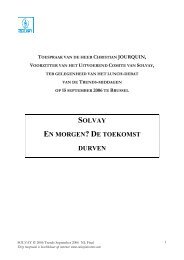
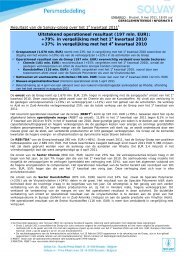

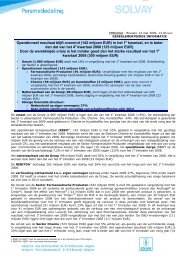
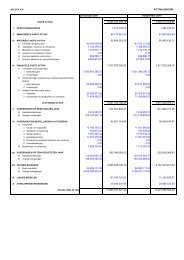

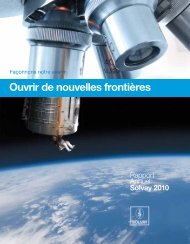
![PROC.1 [LETTRE] - Solvay](https://img.yumpu.com/16585746/1/184x260/proc1-lettre-solvay.jpg?quality=85)
